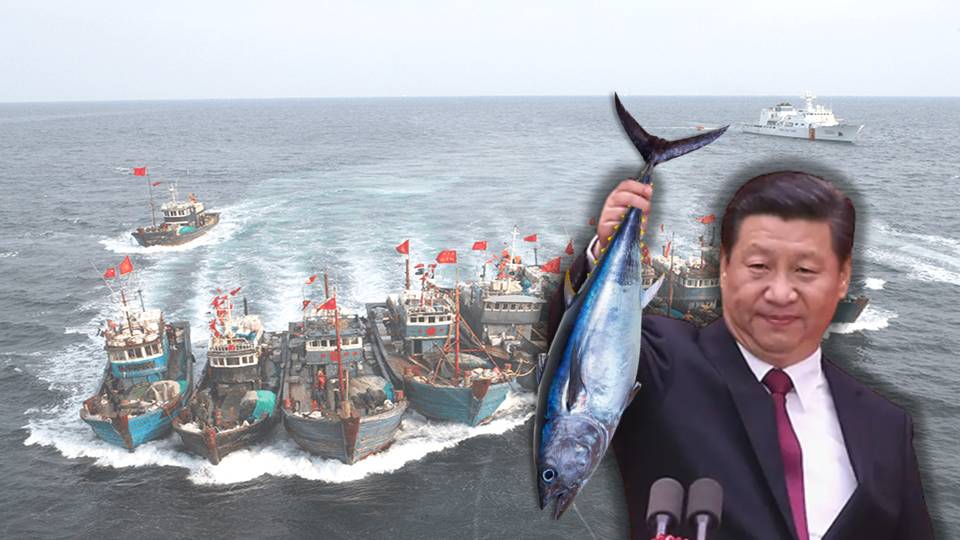When China’s economy is a part of any discussion, rarely will you find people talking about its imports. International market is flooded with cheap Chinese products. It is true that China does not rely much on imports for its domestic consumption. It relies on theft and fisheries probably comprise the largest percentage of its loot.
Chinese ships engaged in stealing
In April this year, Environmental Justice Foundation (EJF) came out with an investigative piece on China’s illegal fishing. 95 per cent of crew members they talked to said that they had witnessed illegal fishing by the Chinese. 85 per cent said that their working conditions were abusive, while 58 per cent had suffered physical violence in the hands of the Chinese. Most of these crew members are working for Chinese distant water vessels.
Apparently, China is the largest consumer of illegal fish in the world. China tops the chart of countries engaged in illegal, unreported, and unregulated fishing. The list was prepared after analysing coastal areas in 152 countries. The 2021 IUU index explicitly states that Chinese ships do not care for any maritime boundary and easily cross the demarcated zones. China alone is responsible for 38 per cent of distant-water fishing operations of the world’s ten largest fleets fishing in other nations’ waters.
Extent to which ‘trade’ has expanded
Expectedly, regions close to the East China Sea and South China Sea witness Chinese fishing fleets crossing international boundaries. However, the South American region, West African region and even North Korea are some of the other regions where Chinese fishing vessels have left their footprints.
According to a study by Yale University, China has anywhere between 2 lakh to 8 lakh fishing boats. These boats conduct nearly half of global fishing activities. However, it is China’s distant water fishing fleet which is causing havoc all around the globe. Though, the Chinese state claims that they have only 2600 distant water vessels, but as usual it is heavily under-reported.
State sponsored illegality
ODI, a global affairs think tank, found in its analysis that China controls over 17,000 distant water vessels. How does China manage them? Well, the ownership of these fleets is fragmented into various companies. The companies register their vessels in Liberia, Panama, and some Pacific and Caribbean island states. In terms of regulations, these companies have tacit support from the Jinping administration.
However, in terms of funding, the Chinese state makes no bones about it. China provides huge subsidies to its fisheries sector. Astoundingly, a humongous 94 per cent of this subsidy covers shipping fuel. Pause for a moment and think about it. What Xi Jinping does is give Rs $347,000 to every vessel and tell them to cross international maritime boundaries in search of fish. How much is it? Well, for context, the European Union provides only $23,000 to vessels on average.
Jinping does not want his population to be effeminate
To be fair to China, there are bigger reasons behind it. If you have watched Chinese movies, their fighters rely on martial arts, which is based on a lean and thin body. But, it does not work much in real life. Muscular Indian soldiers thrashing them in Galwan has exposed the fault-lines. Jinping’s emphasis on throwing out effeminate and sissy men emanates from this very fear.
Maybe this is why the Chinese are consuming animal protein in large quantities. An average Chinese consumes nearly 40 kilogram of fish and seafood every year. It translates into the country alone eating up 38 per cent of global fish production. But, excessive exploitation of marine resources in mainland China has left the Chinese with less than 15 per cent of their original fish biomass. This is the main reason why the Chinese own more than 40 per cent of the global foreign fishing fleet.
Too big to put a halt on
Recently, QUAD countries decided to deploy a satellite-based maritime security system to check on China’s illegal fish in the Indo-Pacific. China is responsible for 95 per cent of such activities in the region. It is likely that they will be able to stop Chinese misadventure. But, it is highly unlikely that they will be able to stop what the Chinese are doing in other locations.
For instance, to process the catch of 500 fishing ships, the Chinese are building their separate port, located west of Montevideo. In Mozambique, they catch 60,000 tons of fish a year. To process them, they took over the port of Beira and doubled its capacity. In Northwest Africa, they built 20 fishmeal plants to process Sardinella, a once-abundant and highly nutritious mackerel-sized fish. North Korean fishing waters too are under China’s grip.
Apart from consuming fish, territorial hegemony is one more reason why China does not hesitate to indulge in illegal fishing. The phenomenon provides it with an opportunity to flex its muscles. However, in this regard, China has had to face several jolts in recent years, especially from Vietnam. It will be interesting to see how other countries deal with the issue.
Support TFI:
Support us to strengthen the ‘Right’ ideology of cultural nationalism by purchasing best quality garments from TFI-STORE.COM
